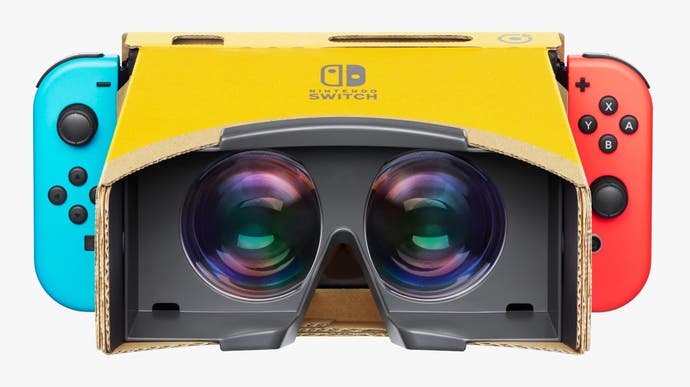Labo VR: how Mario and Zelda look and play in virtual reality
Can Switch handle VR ports of its most advanced games?
Super Mario Odyssey and Zelda: Breath of the Wild running in virtual reality on Switch? Count us in. On paper, the idea sounds insane - but from Gear VR to Oculus Quest, there's a proven track record of mobile chipsets delivering some good experiences. On top of that, as Martin and Ian have already described, Labo VR's various demos, games and experiences are an absolute delight. But pushing VR to titles that already tax Switch hardware to its limits? That's another challenge altogether.
Easily the most ambitious exercise from Nintendo is migrating the entirety of Zelda: Breath of the Wild into virtual reality. The idea is that you can play in Switch handheld or docked configuration as per normal, but when the mood strikes you, you can pick up the console, insert it into the Toy-Con cardboard shell and switch the view into full VR.
And it's at this point where the key compromises become clear. Virtual reality works best by using a high resolution screen and a high frame-rate, with 60fps the acknowledged minimum for VR experiences - even in the mobile space. Zelda is immediately challenged by deficiencies there on both counts. The standard game runs at 30 frames per second with some performance dips, but these deviations from the target frame-rate are amplified when running in VR - presumably because the entire scene is rendered twice, with unique viewpoints for each eye. The bottom line is that performance jumps between 30fps and 20fps, causing genuine motion sickness problems.
Resolution is also an issue. The Switch itself falls short to other mobile VR solutions owing to its native 720p display - a Gear VR set-up paired with the entry-level Samsung Galaxy S7 will quadruple that pixel count from the off, giving a cleaner image. However, Zelda was built with native 720p rendering in mind, with a dynamic resolution fall-back. Even with the less stable performance, resolution takes a big hit - a pixel-count of the area directly in front of the eye reveals 480p rendering, or something approximate to it. Resolution seems to increase along the periphery, presumably down to the perspective warping to match Labo VR's lens curvature.
Even with these issues, the VR implementation itself doesn't feel quite right. Head movements are linked to the camera motion around Link - almost like mapping the right analogue stick to your head. A first-person viewing mode would have made a lot of sense, but the best you can do here is to turn off the Switch's gyroscope within the menu, giving you a fixed view instead and returning camera movements to the right stick - in effect, turning your VR experience into a simpler 3D viewer instead. Adding to the challenge is the removal of the on-screen mini-map from the VR viewpoint, meaning you need to constantly switch to the full map in the settings menu, instead.
Ultimately, Breath of the Wild VR aims high with integration into the complete game, but falls short in just about every regard as an actual gameplay experience. Think of it as a value-added curiosity as opposed to a killer app that makes Labo VR an unmissable purchase - a description that also fits the Super Mario Odyssey VR mode perfectly. There are some very cute moments in this one at least, including the ability to watch the game's beautiful engine-driven cinematics in VR, which are a treat.
The playable VR portion of Mario Odyssey is short-lived, but interesting nonetheless. Three of the game worlds get a VR offshoot lasting five minutes, each only playable when you have unlocked the level in the main game. The idea is to control Mario around a segment of these kingdoms, with your position fixed to one spot in the centre of the map, given freedom to turn a full 360 degrees to keep Mario in sight. There are rare perspective changes once you find a hidden area, and overall, this avoids the motion sickness issues of Zelda's free-flying camera.
There's another plus point. Unlike Zelda, frame-rate is locked to a 60fps with no performance drops whatsoever, which makes the presentation a lot more comfortable. Resolution is still an issue though, with the same 480p-esque pixel counts I noted in Breath of the Wild. Sadly, Mario can also travel quite far 'into' the world from your viewpoint, and despite an ability to zoom the camera, he's often only distinguishable by a few pixels in the distance. It's too blurry. Being able to move between more fixed spots within each level might have made a difference.
What we're left with is a dipping of the toe from Nintendo, with some ideas paying off more than others. It's worth taking a look at the bundled Labo mini-games at least, if you've purchased the Labo Starter Kit. In truth though, the most fun I had really was in building the Toy-Cons using Nintendo's smartly designed tutorials. Everything is clearly labelled and marked, and a bulk of the satisfaction came from seeing the finished product, rather than playing the VR vignettes. Porting existing Switch heavy hitters to VR seems to be a challenge meanwhile, based on the Zelda and Mario experiences. I also can't help but wonder whether the system's other titles might have translated more smoothly. Mario Kart 8 Deluxe in VR would have been a strong candidate for VR support for example - at least taken from a cockpit view - and I'd be interested to see how (and if) Nintendo chooses to follow up on this initial brace of releases with more.










